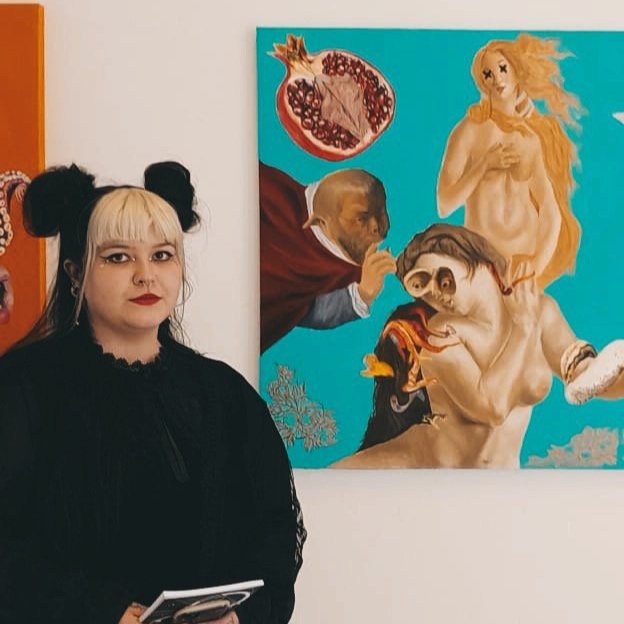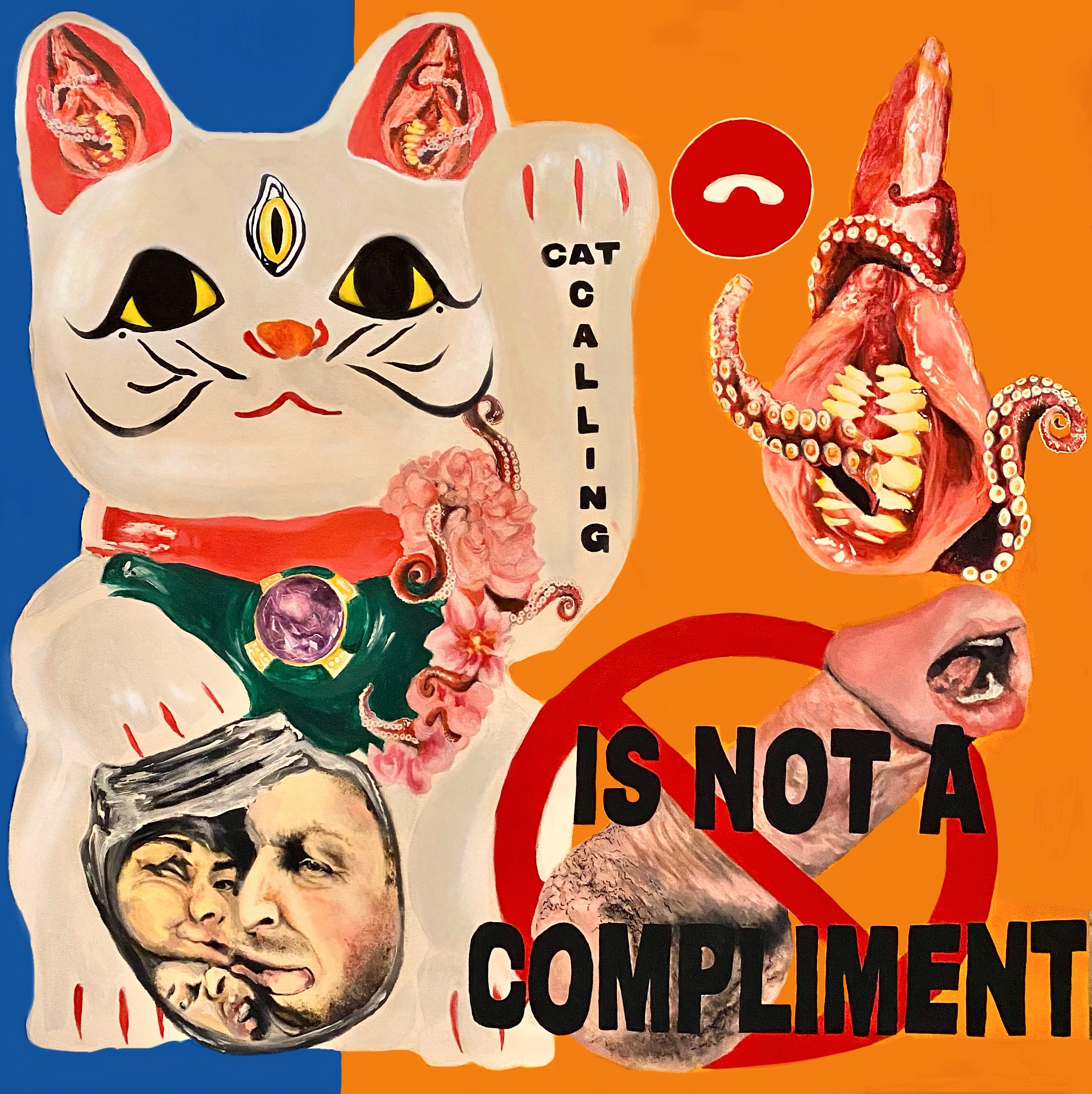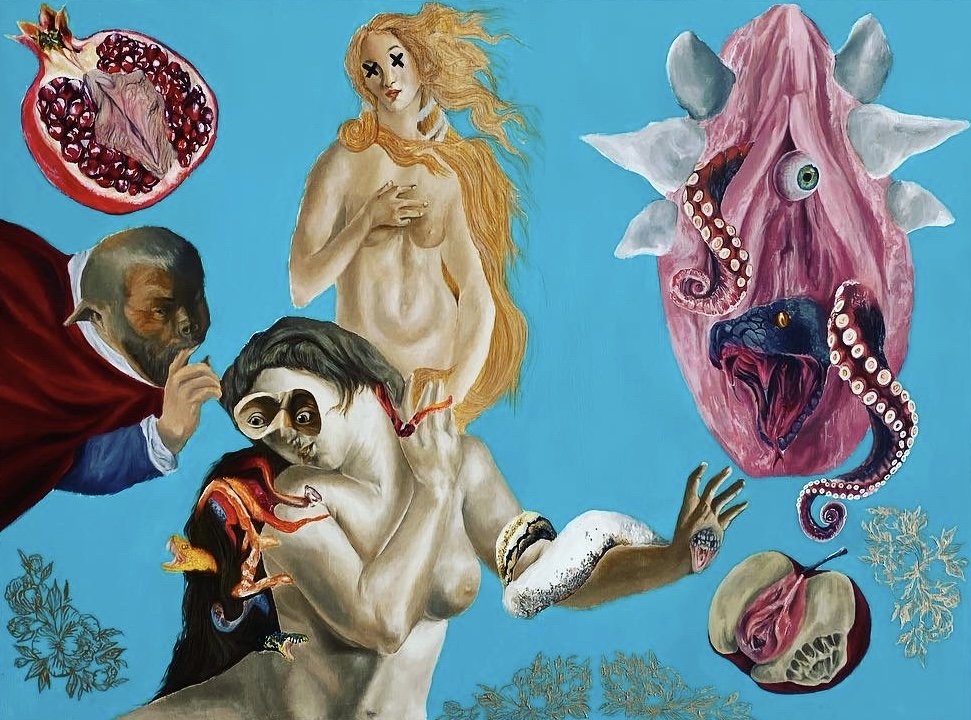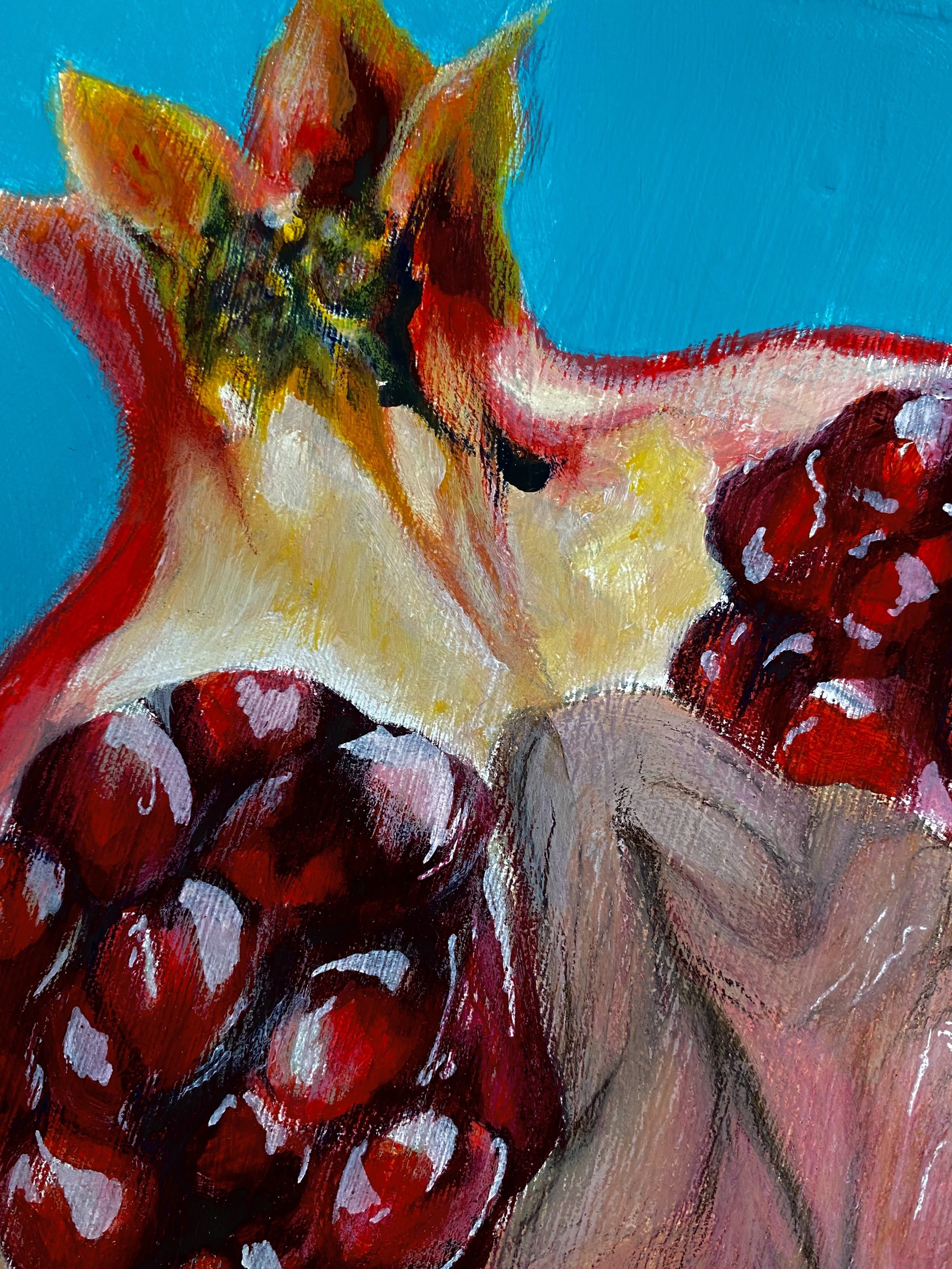10 Questions with Caitlin Smith
Caitlin Smith is a multidisciplinary surrealist completing her master's degree at the University of Sunderland. Working with a plethora of mediums, Smith favours relief printmaking processes & painting, acrylic being her preferred choice. At present, her practice explores the figurative narrative of the internalised femme fatale, conjuring fragmented paintings and prints. She strives to eradicate the unspoken autocracy and biased attitudes implemented within both society & the Arts, alongside prioritising inclusivity and representation. Smith visually transcribes an outrageous oeuvre displaying themes of politics, societal taboos, and conflict.
Referring to the theory demonstrated by poststructuralism, Caitlin's practice confronts the notion of gender biases and stereotypes. She creates works that shift the objectification of women and marginalised genders onto men, conveying a reciprocated image that depicts the man as the subject of societal standards and scrutiny. Smith celebrates women's bodies as they are, rather than the subject of degradation and sexualisation.
Caitlin Smith - Portrait
“I hope to disrupt and extinguish the prevailing prerogatives of the patriarchy and resist the social conditioning of the so-called gender normative positions, “masculine” and “feminine” – I want to encourage the audience to resonate with and understand the obstructive conformities and social dissection women and marginalised genders have and continue to be, subjected.”
Catcalling is Not a Compliment, Acrylic over stretched canvas, 90x90 cm, 2021-2022 © Caitlin Smith
INTERVIEW
First of all, introduce yourself to our public. What training and experiences helped you become the artist you are today?
I am a surreal artist, and postgraduate student who has recently graduated with a 1st Class Honours Ba and I am about to delve into my Master's degree following a Fine Art pathway. In regards to training, I would consider myself to be a predominantly self-taught artist, as I have practiced with various mediums for over a decade. I had a tough go of it growing up; people telling me I wasn't creative and signing my work was useless and quite presumptuous of me, because how could I possibly go somewhere within this industry? I took these comments and used them as a catalyst to fuel and ignite my creativity. I became further acquainted with different mediums and processes, to prove that I was in fact, creative. I have also experienced horrific incidents of (TW) sexual assault and rape, causing me to break apart and lose myself to a miasma of self-loathing and pain, it was only within my work I could find a catharsis, a voice to be heard. So to answer the question of what experiences have aided in making me the artist I am today, I would say the comments and actions of narcissists, bullies, and predators. I will not be bound by trauma, instead, I will utilize it and create works that expose the behaviours of those who hold a phallocentric worldview.
What is your artistic background? And when did you first realize you wanted to be an artist?
As cliche as it sounds, Arts and Crafts were something I was interested in from the ages of 3 onwards. By 9 years old, I was drawing daily, and helping classmates draw different elements to pictures they were creating. I remember in Year 6, so I was almost 11 at this point, I was asked to do a life-size drawing of Queen Elizabeth I, and I felt so elated, it was my first big project! Throughout secondary school, I continued to have an interest in the Arts and GCSE options rolled around, and I knew it was a pathway I wanted to take. From school to college and now to university for my Master's degree, I have taken this pathway as I want to help individuals express rather than repress their emotions. I want to show others how they can free themselves from the convoluted abyss of degradation and internalised anger; to step into a world of their imagination, so to speak. I have always been an artist.
What are the main themes behind your work? And what does your art aim to say to the viewers?
At the forefront of my practice, there is an exploration of the femme fatale, using stereotypical feminine nuances as a foundation to mock and expose the phallocentric. I create a new prerogative for the woman, conjuring a comical, matriarchal vision, in which the man is subjected to the social scrutiny that women and marginalised genders are. Influenced by the resolute provocations of Judith Bernstein, specifically, Birth of the Universe I have begun to curate concatenations of enigmatic images and obscurities. I have found Bernstein's influence, primal to the employment of a mordacious narrative, by combining politics with eroticism, the work results in a pronounced juxtaposition. I have started to question and subvert the binaries constructed by society and the self by establishing a visual exposition of how the political pervades the personal and how women and marginalised genders are excluded and denied access across several industries due to gender biases and gender-induced colonisation. By creating works that discuss the prevalence of sexual and gendered violence, the traumatic reality of rape and sexual assault are, revealed to the public lens. I want to call attention to the excruciating agony of the isolation and psychological displacement that other survivors and I experience. I want to provide a catharsis for women and marginalised genders, a utopia in which the phallocentric can experience what we have.
Mansplaining, Acrylic over stretched canvas, 90x90 cm, 2022 © Caitlin Smith
How do you create your works? What is your creative process like?
As I primarily work with paint, I'll explain that process. I don't like to commit to drawing on the canvas straight away, as I am prone to making mistakes and do not like to create friction by rubbing the canvas. I start off by drawing on large pieces of paper; that way, I can shift details and experiment with scale before moving to the canvas. I secure all of the sheets together with masking tape and apply sheets of carbon paper to my canvas. I then trace over the sketch for it to be imprinted over the canvas, creating a mono print. I then begin the tedious process of mixing base values to create a foundation. I always have printed copies of my reference image, which tends to be a photomontage of images I have created to then replicate through paint. I like to colour match directly to the photograph, hence the printouts. My process is quite meticulous and time-consuming, but absolutely ideal if you're afraid of messing up and potentially ruining a material. Once I have gotten into the flow of making tones and continuously building on them, I settle down and listen to a series of true crime podcasts, and paint away.
You work with several different mediums; how do you choose which one is more suitable for a specific project or series?
I mainly work with acrylic paint, so I see this as a potential foundation to build from. If a piece calls for a more elaborate design, then I usually resort to lino printing over the canvas, to further allude to an intrepid allegory. Looking at the work Peony Pussy, I created a painting and decided I wanted to accentuate the values of the work, by creating sculptural forms that held the shape of various vulvas; I found in creating a series of three-dimensional elements the message of interior power, self-love and diversity was heightened. I often use coloured pencils or watercolour pencils to create texture and enhance the rendering of a work. I find using only one medium to be restrictive to the creative process; by combining mediums or securing elements created with a different medium to a piece, the symbolism and meaning of the imagery are intensified. I choose what mediums I combine depending on what I am trying to say, and what imagery I have to work with.
One of the themes you tackle in your work is that of the femme fatale. What are your sources of inspiration? And how did you get interested in that specific theme?
Embodying the poise of femme fatale, I depict works that generate stereotypically effeminate and allusive imagery, I do this to seduce the audience into an artificial sense of delicacy and refinement, to then unveil the obnoxious reality of society and the permeated idolisation of toxic masculinity. I like to work allegorically, mocking the social system of the binary; I use femme fatale to liberate women and marginalised groups, using these typical effeminate nuances as an object of power, to emancipate us from the social conditioning of, we are to be seen but not heard. The subordination of women and marginalised genders is cardinal to the social system with its exigency for power. By exposing the discrepancy of the gender hierarchy and the inexcusable behaviours of the industry, together, we can cease the systematic expulsion of women and minorities. There needs to be an understanding of the historical ideas that have determined the present position of women artists and minorities if we are to challenge the appropriation and derogatory renditions of the woman within a phallo-supremacist system of venereal dominion. I draw inspiration from the works of Judith Bernstein, and the performances of Carolee Schneemann, exploring the obscene body and transgressive aspects of female sexuality and repossessing the female form from the patriarchal spectacle. Like both of these wonderful artists, I want to invigorate a redesigned cultural presence that subverts the male gaze, enabling the woman to be the direct subject of the work through the female gaze.
Untitled, Acrylic and coloured pencil over stretched canvas, 102x83 cm, 2022 © Caitlin Smith
Untitled, Detail © Caitlin Smith
Untitled, Detail © Caitlin Smith
Is there any other theme or technique you would like to experiment with?
Having analysed and studied the blatant atrocities of society, I intend to further my practice through more socially charged works that demolish the patriarchy and social hierarchy. I will continue to visually translate personal incidents regarding rape and sexual assault alongside mocking the patriarchal standards upheld within society and the Arts, conjuring works that relay a message of liberation to the woman and the minority. The objective of my work stands to enable and encourage the audience to develop a better understanding and awareness of the atrocities and inequalities that continue to go on in society today. The theme of my work will not change but broaden further, to help aid in change. As for a technique I would like to try, I am considering hand-stitched embroidery to come into play, as this is a technique I have done in the past as a stand-alone medium. I would like to hand embroider some elements over further paintings to see how the two work together.
What do you think of the art community and market? How do you find opportunities to show your work? And what is your relationship with collectors?
The art community is fabulous for versatility and variety from artists of all backgrounds and positions within their artistic careers, and it's beautiful to see so many movements be explored and orchestrated in different ways. There is, however, a flip side to this variety though, and that is the censorship of women and marginalised genders' work, the STILL evident preference for males within gallery spaces, and the art market problem of women and minority works being valued less. For every £1 a male artist makes, a female artist makes 10p. Navigating the art community can be difficult and sometimes overwhelming, especially when you're just starting out. I search for opportunities through Instagram, Curator Space, Submittable, and Call for Entries. I also tend to search for artist platforms that offer publication opportunities and contact local zine makers to be featured. I have yet to meet any collectors, but I do have some amazing friends who purchase original lino prints and gloss prints to show their support and jazz up their spaces.
Peony Pussy, Acrylic over stretched canvas with air dry clay hand-sculpted vulvas suspended by red yarn, 90x90 cm, 2022 © Caitlin Smith
What are you working on right now? Anything exciting you would like to tell our readers?
I don't like to give away too much as this is a project I have just begun to map out, but the details I will give you are; this is the biggest work I am going to create at present, standing at 6 feet tall and 8 feet long. The imagery within this piece will, of course, hold an allegorical undertone with religious parallels. I am creating my own version of one particular scene within the Christian faith, and I am making it a Matriarchal celebration. The mediums I will be working with include acrylic and coloured pencil, and I may embark on hand-stitched embroidery within this piece.
You are still very young. Where do you see yourself five years from now?
Five years from now, I'd like to be a practising artist, exhibiting locally and perhaps throughout the UK. I'd be a few years into my university lecturing job, working on my Ph.D. Fame and recognition are not my goals; my goal now and five years from now, is to contribute to change. Becoming established would be great, but for me, it's not the be-all and end-all. I want to help all of the people that I can, and make a difference within society. I hope by continuing to create outrageous displays of feminism, I can change the views of some audiences and promote equality for all.






















